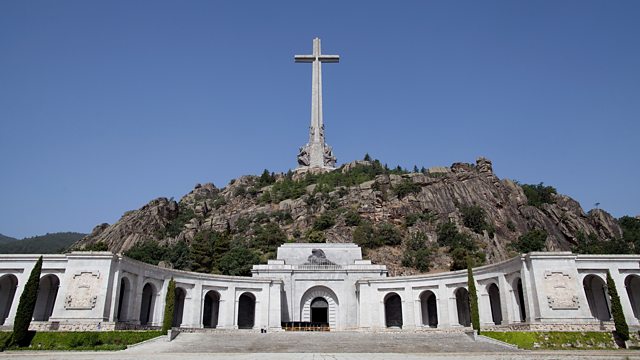24/06/2014
History magazine programme presented by Helen Castor and Tom Holland. Including what the French really thought about the Allied bombing raids on their cities.
Helen Castor and Tom Holland return with the latest research that's Making History.
Today's programme includes what the French really thought about the Allied bombing raids on their cities, why the Spanish still can't face remembering their civil war, and London to Great Yarmouth in around 10 minutes - 200 years ago.
Contact the programme: making.history@bbc.co.uk
Presenter: Helen Castor
Produced by Nick Patrick
A Pier production for �鶹������ҳ��� Radio 4.
Last on
The Valley of the Fallen
Further information:
- ��
- ��
- Sarah Rainsford of �鶹������ҳ��� News visited the Valley of the Fallen on the 75th anniversary of the start of the Spanish Civil war in 2011.
Criminals or Liberators?
Seventy years on from D-Day it’s easy to forget the death and destruction that the Allied bombing campaign brought to the people of France. Indeed, as many French civilians died on the day of the landings as Allied servicemen. Dr Simon Kitson has explored how the French population felt about the air war on France in a recent paper and here he talks to Helen about his findings.
- ��
Admiralty Shutter Telegraph
Making History listener Kay Baker served as a Communications
Officer in the Royal Navy for many years. But, it was the colour illustration
below, which see saw at the National Maritime Museum in Greenwich, that
inspired her to research a forgotten communications system from the Napoleonic
era.
Kay thinks that this a propaganda cartoon which is re-enforcing the French threat to Britain. What struck her was the object on top of the castle, crowned by a French flag. She thinks its a pictorial representation of a telegraph system with six shutters which, when opened and closed, could send messages via a chain of shutter stations in minutes. These loines of communication ran from the Admiralty in Whitehall to: Chatham and Deal; Portsmouth, Plymouth and Great Yarmouth. Such was her interest that she made the latter the centre for her research when she signed up for a MA in Landscape History at the University of East Anglia.
��
Making History enlisted the help of naval historians Professor Roger Knight at Dr Sam Willis to find out more.
Useful Reading
Britain Against Napoleon. The Organization of Victory. 1793 - 1815 by Roger Knight
Can you help?
Can you help Kay research the Admiralty Shutter Telegraph line from London to Great Yarmouth? This is a list of the stations with their map references. The Making History team would be thrilled if you could send an image of one of the sites below, especially if there is evidence of a former telegraph station.��
Information on how to contact the Making History team is .
Please ask landowners’ permission.
The Admiralty to Great Yarmouth Shutter Telegrah
1.���������� Admiralty:�� Whitehall (TQ 301 801)
2.���������� Royal Hospital Chelsea:�� West wing of the inner quadrangle (TQ
280 782)
3.������ Hampstead: ��Intersection between Platt’s Lane and West Heath Road, also known as Hermitage Lane, on Telegraph Hill (TQ 253 864) ��
4.���������� Woodcock Hill: On the ridge of Borehamwood Station Elstree Tunnel (TQ 195 953)
5.���������� St Albans:�� Roof of the clock tower in the market place (TL 147 073)
6.������ Dunstable: Top of the Downs in the angle of the road from Dunstable to Whipsnade and Kensworth Common (TL 008 194) ��
7.���������� Lilley Hoo:�� North of Lilley on Telegraph Hill (TL 118 288)
8.���������� Baldock:�� Western Hills (TL 352 324)��
9.���������� Royston:�� Southeast of town (TL 349 391)
10.�� Gog Magog Hills:�� Wandlebury Telegraph Clump (TL 494 538) ��
11.�� King’s Chair:�� Newmarket, Long Hill near Warren Towers north of Moulton Road (TL 664 639)
12.�� Icklingham:�� Telegraph Plantation (TL 785 738) ��
13.�� Barnham: South of Dukes Ride between the 8th and 9th milestones on the Thetford to Bury Road (TL 872 776)
14.�� East Harling:�� Telegraph Hill (TM 008 865)��
15.�� Carleton Rode:�� Telegraph Farm (TM 098 934)
16.�� Wreningham:�� Next to former ruins of St Mary’s church tower (TM 148 983)��
17.�� Mousehold:�� Telegraph Lane from Thorpe Road (TG 245 088)
18.�� Strumpshaw:�� Strumpshaw Hill south of church (TG 354 074)��
19.�� Yarmouth:�� South Denes (TG 529 065)
Broadcast
- Tue 24 Jun 2014 15:00�鶹������ҳ��� Radio 4 FM
Podcast
-
![]()
Making History
Popular history series where the past connects with the present.


